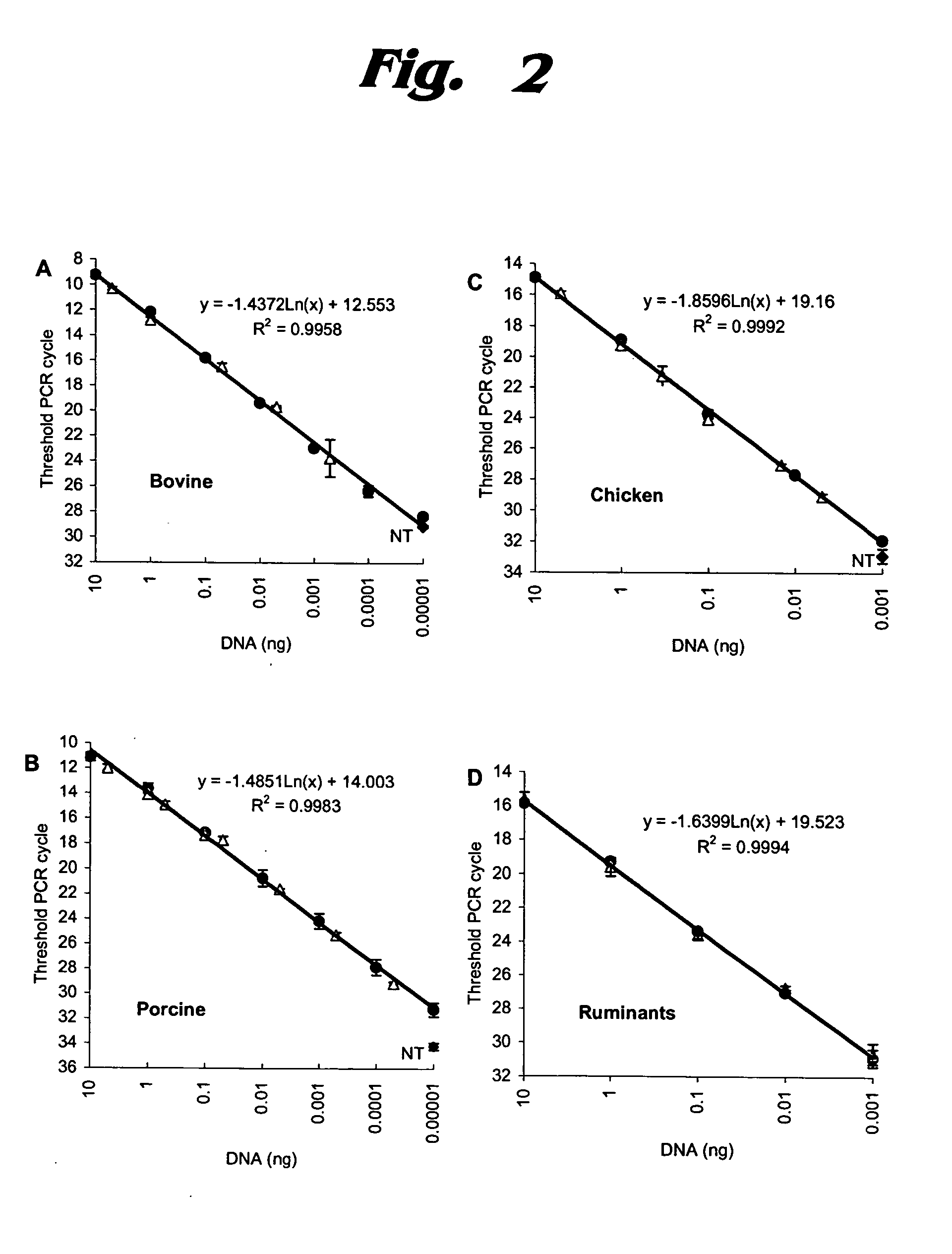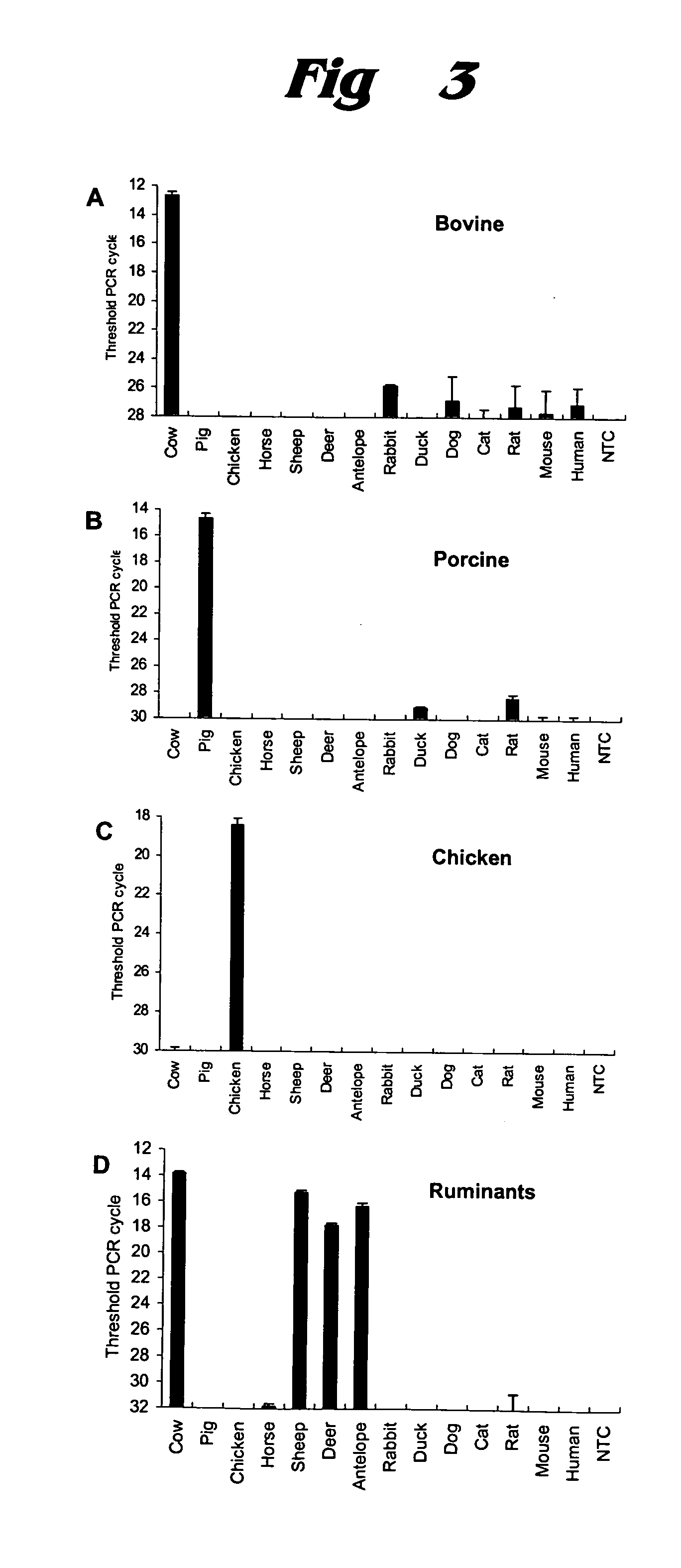Assay for species sources
a technology for species sources and assays, applied in the field of assays for species sources, can solve the problems of inability to detect sensitive ruminant species in animals, inability to use labeling practices of commercial suppliers or grocery stores, and inability to use labeling practices that are unacceptable, so as to improve the low-range detection limits of assays and the cost of performing assays.
- Summary
- Abstract
- Description
- Claims
- Application Information
AI Technical Summary
Benefits of technology
Problems solved by technology
Method used
Image
Examples
example 1
Agarose Gel Fluorescence Meat Assays
[0061] 30 cycles of conventional PCR were carried out using 2 ng of template DNA (extracted by conventional means) from six different commercially purchased meat products. The amplified products were chromatographed on a 2% agarose gel stained with ethidium bromide. The detection was performed in the visualization of FIG. 5A with bovine DNA using the 1.711B bovine repeat assay. The detection was performed in the visualization of FIG. 5B with porcine DNA using the intra-PRE-1 SINE assay. The detection was performed in the visualization of FIG. 5C with chicken DNA using the intra-CR1, subfamily “C” SINE assay. The detection was performed in the visualization of FIG. 5D with ruminant DNA using the intra-Bov-t-A2 assay.
[0062] Lanes: (1) 100 bp DNA ladder; (2) negative control; (3) positive control DNA (A, bovine; B, porcine; C, chicken; and D, ovine); (4) ground beef; (5) ground pork; (6) ground lamb; (7) pork sausage; (8) chicken sausage; (9) mixed...
example 2
Quantitative PCR Meat Assays
[0065] Quantitative PCR analysis was undertaken for six meat samples, using the same primers and SYBR Green fluorescence detection. Results are shown in FIG. 6. (The Applied Biosystems Web page at http: / / www.applied biosystems.com / catalog / myab / StoreCatalog / products / CategoryDetails.jsp?h ierarchyID=101&category3rd=112235&trail=no provides information about SYBR® Green PCR Master Mix. Sigma-Aldrich has provided further information on SYBR Green chemistry at http: / / www.sigmaaldrich.com / Area_of_Interest / Life_Science / Life_Science_Quarterly / Winter—2002 / SYBR_Green_Feature_Article.html.)
[0066] In FIGS. 6A through 6D, the six products were labeled as follows: (a) ground beef—open triangles; (b) ground pork—open squares; (c) ground lamb—open circles; (d) pork sausage—filled triangles; (e) chicken sausage—filled squares; (f) mixed beef and pork sausage—filled circles. The PCR cycle at which the fluorescent signal crosses baseline is considered to be the threshold ...
example 3
Taq Man Pork Assay
[0070] A TaqMan probe for the PRE-1 intra-SINE porcine detection assay was designed: 5′ FAM-TTTGATCCCTGGCCTTGCTCAGTGG-TAMRA 3′. The assay of FIG. 6B was then performed with this probe and the results were compared with the SYBR Green-based pork assay of Example 2 and FIG. 6B. The assay sensitivity was, unexpectedly, almost the same. It appears that at least the 5′-FAM reporter molecule typically used with TaqMan-based detection chemistry is not significantly different from SYBR Green in sensitivity.
[0071] A second TaqMan probe (using a non-TAMRA quencher) and primer set was designed for a PRE-1 intra-SINE assay. This detection system was approximately as sensitive as the SYBR Green-based detection system in terms of linear quantitation of a pig DNA sample. But this detection system is considered a less preferred mode than SYBR Green-based detection because of cross-species amplification leading to a higher background signal from other species with mixed samples. ...
PUM
| Property | Measurement | Unit |
|---|---|---|
| volume | aaaaa | aaaaa |
| volume | aaaaa | aaaaa |
| agarose gel electrophoresis | aaaaa | aaaaa |
Abstract
Description
Claims
Application Information
 Login to View More
Login to View More - R&D
- Intellectual Property
- Life Sciences
- Materials
- Tech Scout
- Unparalleled Data Quality
- Higher Quality Content
- 60% Fewer Hallucinations
Browse by: Latest US Patents, China's latest patents, Technical Efficacy Thesaurus, Application Domain, Technology Topic, Popular Technical Reports.
© 2025 PatSnap. All rights reserved.Legal|Privacy policy|Modern Slavery Act Transparency Statement|Sitemap|About US| Contact US: help@patsnap.com



